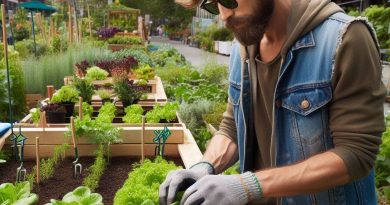Winter Gardening: Essential Tools & Tips
Last Updated on February 8, 2024
Introduction
A. Why winter gardening is important and beneficial
Winter gardening is an essential practice that brings numerous benefits to garden enthusiasts.
Despite the cold temperatures, winter gardening allows individuals to continue nurturing their plants, ensuring they thrive all year round.
In this blog section, we will explore the importance and benefits of winter gardening, as well as discuss the essential tools and tips needed for success.
The winter season presents unique challenges to gardeners, including frost, cold winds, and limited sunlight.
However, by taking appropriate measures, one can maintain a thriving garden even during the coldest months.
Winter gardening is important because it allows you to continue enjoying the beauty of nature and provides a sense of accomplishment.
Additionally, it helps to improve mental well-being by engaging in a calming and therapeutic activity during the winter months.
B. Brief overview of the essential tools and tips to be discussed
To successfully garden during winter, it is crucial to have the right tools and knowledge.
Some of the essential tools that will be discussed include insulated gloves, garden coverings, and a quality hand shovel.
These tools are necessary for protecting plants, removing snow, and maintaining soil health.
Additionally, we will provide tips on how to prepare your garden for winter, such as proper mulching, choosing cold-hardy plants, and creating a winter watering routine.
Therefore, winter gardening is an important and beneficial practice that allows gardeners to continue nurturing their plants and enjoying the therapeutic benefits of gardening throughout the cold season.
By utilizing essential tools and following practical tips, individuals can create a thriving winter garden that adds beauty and tranquility to their surroundings.
Stay tuned for the next sections as we delve deeper into the tools and tips for successful winter gardening.
Essential Tools for Winter Gardening
During the winter months, maintaining a garden can be a challenging task.
However, with the right tools and tips, it is possible to keep your garden thriving even in the coldest of seasons.
In this blog section, we will explore the essential tools required for winter gardening, the importance of quality tools, and provide examples of specific tools for different tasks.
We will also offer tips on how to choose the right tools for specific winter gardening activities.
A. Essential Tools for Winter Gardening
Different types of gardening tools are required for winter gardening compared to other seasons.
Due to the harsh weather conditions, these tools must be sturdy, durable, and capable of withstanding the cold temperatures.
With the proper tools, you can effectively maintain and protect your garden during the winter months.
B. Importance of Quality Tools
Investing in quality tools is vital for achieving effective results in winter gardening.
High-quality tools are designed to withstand the harsh conditions, ensuring they do not break or rust easily.
Inferior tools can cause damage to plants and hinder the progress of your gardening efforts.
C. Examples of Essential Tools
- Hand Pruners: Hand pruners are essential for cutting and pruning branches and stems.
They provide precise cuts, promote healthy growth, and enable proper shaping of plants. - Garden Rakes: Garden rakes are useful for removing debris, leaves, and excess moisture from the soil.
They help maintain proper air circulation and prevent the growth of harmful molds or fungi. - Snow Shovels: Snow shovels are indispensable for clearing snow from walkways, garden paths, and around plants.
Removing excessive snow prevents damage and allows sunlight to reach the plants.
D. Tips for Choosing the Right Tools
- Consider the Material: Opt for tools made from durable materials such as stainless steel or carbon steel. These materials ensure longevity and resistance to rust.
- Handle Length and Grip: Select tools with comfortable handles that provide a secure grip, reducing strain on your hands and wrists during prolonged use.
- Ergonomic Design: Look for tools with ergonomic designs that are easy to handle and minimize fatigue. This is particularly important for tasks that require repetitive movements, such as pruning or raking.
- Compatibility: Choose tools that are suitable for specific winter gardening tasks. For instance, select pruners with adjustable blade tension for cutting different plant sizes.
- Storage and Maintenance: Consider tools that are easy to store and maintain. Look for tools that can be hung on a wall or stored in compact spaces to save room in your garden shed.
Most importantly, having the right tools is crucial for successful winter gardening.
By investing in high-quality tools like hand pruners, garden rakes, and snow shovels, you can effectively address the challenges of winter and keep your garden healthy.
Remember to choose tools that are suitable for specific winter gardening tasks and consider factors such as material, handle grip, ergonomic design, and ease of storage and maintenance.
With the right tools and proper care, you can enjoy a beautiful and thriving garden even during the colder months.
Read: Native Plants: Low-Maintenance Gardening
Tips for Winter Gardening
A. Importance of selecting the right plants for winter gardening
When planning a winter garden, it is crucial to choose plants that can withstand cold temperatures.
Some excellent choices include winter-blooming flowers like pansies, hellebores, and snowdrops.
These hardy plants can add color and beauty to your winter garden.
B. Tips for preparing the soil before planting
Before the winter season arrives, it’s important to prepare the soil to ensure optimal growth for your plants.
Start by removing any debris, weeds, or dead plants from the garden bed.
Then, add organic matter, such as compost or well-rotted manure, to enrich the soil.
This will provide essential nutrients for the plants during the winter months.
C. Suggestions for protecting plants from frost and extreme weather conditions
Winter weather can be harsh, so it’s crucial to take steps to protect your plants from frost and extreme weather conditions.
One effective method is to use frost covers or blankets to shield delicate plants from freezing temperatures.
Additionally, mulching around the base of plants can help insulate the roots and retain soil moisture.
D. Advice on watering techniques and frequency during winter
Proper watering is essential for maintaining a healthy winter garden.
Watering should be done in the morning to allow plants sufficient time to dry before evening, reducing the risk of frostbite.
However, be cautious not to overwater, as this can lead to root rot in cold soil.
E. Tips for managing pests and diseases in winter gardens
Despite the colder temperatures, pests and diseases can still pose a threat to your winter garden.
Inspect your plants regularly for signs of infestation or disease, such as wilting, discoloration, or unusual growth patterns.
Use organic pest control methods, such as neem oil or insecticidal soaps, to keep pests at bay.
Furthermore, practicing good garden hygiene by removing dead leaves and plant debris can help prevent the spread of diseases.
In essence, winter gardening requires careful consideration and preparation to ensure successful plant growth.
By selecting the right plants, preparing the soil, protecting plants from frost, adopting proper watering techniques, and managing pests and diseases, you can create a thriving winter garden that adds beauty to the coldest months of the year.
Read: Raised Bed Gardening: Pros and Cons
Cold Frame Gardening
Winter gardening can be a challenging but rewarding endeavor.
One effective technique for gardening during the cold season is using cold frames.
Cold frames are versatile structures that provide a controlled environment for plants, protecting them from low temperatures, frost, and other harsh winter conditions.
By understanding the benefits of cold frames and learning how to construct and maintain them, you can extend your gardening season and grow a variety of plants even in the coldest months.
A. Cold Frames and their Benefits in Winter Gardening
A cold frame is a simple and low-cost structure typically made of a wooden frame and covered with transparent materials such as glass or rigid plastic.
It acts as a mini greenhouse, capturing and retaining natural heat from the sun to create a warmer microclimate for plants.
This allows gardeners to start seeds earlier in the year, protect delicate plants, and even grow vegetables during the winter.
The benefits of cold frames in winter gardening are numerous.
Firstly, they provide insulation, reducing heat loss and protecting plants from freezing temperatures.
Secondly, they offer shelter from strong winds and heavy snow, preventing damage to fragile plants.
Thirdly, cold frames create a humid environment, reducing moisture loss and maintaining adequate hydration levels for plants.
Lastly, they provide a controlled space for acclimating plants to outdoor conditions before transplanting them into the garden.
B. Step-by-Step Guide for Constructing a Simple Cold Frame
- Select a suitable location for your cold frame, preferably facing south to maximize exposure to sunlight.
- Construct a wooden frame in the desired dimensions, making sure it is sturdy and level.
- Add a hinged top to the frame using transparent materials such as glass or rigid plastic.
- Ensure the top is slanted to allow rain and snow to slide off easily.
- Secure the transparent materials firmly to prevent them from blowing away during strong winds.
- Position the cold frame over a prepared bed or soil, ensuring it is level and stable.
- Fill the bed with a mix of compost and soil, creating a nutrient-rich growing environment.
- Monitor the temperature inside the cold frame regularly and adjust ventilation accordingly.
- Water the plants as needed, taking care not to overwater or let them dry out.
- Harvest crops when ready, and continue to care for the plants throughout the winter season.
C. Tips for Using and Maintaining a Cold Frame Effectively During Winter
- Open the cold frame during sunny days to regulate temperature and provide fresh air.
- Cover the cold frame at night with an insulating layer such as straw or bubble wrap.
- Monitor the moisture levels inside the cold frame and water accordingly to prevent dehydration.
- Remove any excess snow or ice buildup on the frame to prevent damage.
- Inspect the structure regularly for any signs of damage or wear and make necessary repairs.
- Keep an eye out for pests and diseases, and implement appropriate control measures if necessary.
- Rotate crops each year to maintain soil fertility and prevent the buildup of pests and diseases.
D. Examples of Suitable Plants for Cold Frame Gardening
Cold frames can accommodate a wide range of plants suitable for winter gardening.
Some popular options include cold-tolerant vegetables like kale, spinach, and carrots.
Fragile perennial flowers and herbs, such as pansies and thyme, can also thrive in cold frames.
Additionally, cold frames offer a perfect environment for starting seeds of early-season crops such as lettuce and radishes, giving gardeners a head start for the upcoming spring.
In fact, cold frames are invaluable tools for winter gardening.
Understanding the benefits, constructing a simple cold frame, and following proper maintenance practices will enable you to enjoy growing plants all year round.
By experimenting with suitable plants for cold frame gardening, you can successfully extend your growing season and experience the joy of fresh produce even during the chilly winter months.
Read: Greenhouse Tips for Small-Scale Farmers

Mulching and Insulation Techniques
When it comes to winter gardening, mulching and insulation techniques are essential for protecting your plants.
In this section, we will discuss the importance of mulching and insulation, different materials to use, and how to apply them correctly.
A. Importance of Mulching and Insulation in Winter Gardening
- Mulching and insulation help regulate soil temperatures, preventing frost damage to plants.
- They also help retain moisture in the soil, reducing the need for watering during the winter months.
- Mulching and insulation act as a barrier, protecting plant roots from extreme cold and temperature fluctuations.
- By providing an extra layer of protection, they can extend the growing season and promote healthy plant growth.
B. Different Types of Mulch and Insulation Materials to Use
There are various types of mulch and insulation materials available for winter gardening.
Here are a few options:
- Organic Mulch: This includes materials like straw, wood chips, leaves, and compost. They provide nutrients as they break down and improve soil structure.
- Plastic Mulch: This non-biodegradable option helps retain moisture and heat in the soil.
- Insulation Blankets: These blankets are made of breathable fabric and provide an extra layer of protection to plants.
C. Instructions on Correctly Applying Mulch and Insulation
Proper application of mulch and insulation is vital to ensure maximum benefits for your plants.
Follow these guidelines:
- Clean the garden area by removing any debris, weeds, or old mulch from the previous season.
- Water the soil thoroughly before applying mulch to help retain moisture.
- Spread a layer of mulch around the plants, leaving a small gap around the stems to prevent rotting.
- For insulation blankets, wrap them loosely around the plants, securing them at the base.
D. Tips for Removing Mulch and Insulation in Spring
As winter comes to an end, it is important to remove the mulch and insulation properly.
Here are some tips:
- Wait for the soil to warm up and the risk of frost to pass before removing mulch and insulation.
- Rake away the mulch gently, being careful not to damage any emerging plants.
- Collect and compost the mulch for future use or dispose of it responsibly.
- Remove insulation blankets, clean them if necessary, and store them for reuse next winter.
In short, mulching and insulation techniques play a crucial role in protecting your plants during the winter months.
By understanding their importance, selecting the right materials, and applying them correctly, you can ensure the survival and well-being of your winter garden.
Read: Microgreens: Farming in Tiny Spaces
Preparing for Spring
A. Suggestions for the final winter garden clean-up
- Remove all dead plants and debris from your garden beds to prevent disease and pests.
- Trim back any overgrown branches or shrubs to promote healthier growth in the spring.
- Rake up any fallen leaves or mulch to expose your soil to the sun and allow for proper drainage.
- Clean and sharpen your garden tools to ensure they are ready for use in the upcoming season.
B. Tips for starting seeds indoors for early spring planting
- Choose the right containers, such as seed trays or peat pots, with good drainage.
- Use high-quality seed starting mix for best germination results.
- Provide adequate lighting by placing the seedlings near a south-facing window or using grow lights.
- Maintain proper moisture levels by misting lightly with water or using a seedling heat mat.
- Transplant the seedlings to larger pots when they have developed their first set of true leaves.
- Harden off the seedlings gradually by exposing them to outdoor conditions before planting them in the garden.
C. Importance of planning and organizing for the coming gardening season
- Determine your gardening goals and make a list of the plants you want to grow.
- Create a garden layout or design to optimize the use of space and ensure proper plant placement.
- Plan your planting schedule based on the frost dates in your region.
- Organize your gardening tools, seeds, and supplies to make them easily accessible when needed.
- Research and prepare for any specific requirements or challenges that may arise in your garden.
D. Suggestions for continuing to care for plants during the transition from winter to spring
- Gradually increase watering as the weather warms up to meet the plants’ growing needs.
- Provide protection from unexpected cold snaps by covering plants with frost blankets or cloths.
- Prune any damaged or diseased branches to prevent further spread of infections.
- Fertilize your plants with a slow-release or organic fertilizer to promote healthy growth.
- Keep an eye out for early signs of pests or diseases and take appropriate measures to control them.
- Monitor weather forecasts and be prepared to protect your plants from heavy rain or extreme temperatures.
By following these tips and planning ahead, you’ll be well-prepared for the arrival of spring and enjoy a thriving garden throughout the season.
Conclusion
A. Recap of Essential Tools and Tips
- Shovel: Essential for digging through frozen ground.
- Hand pruners: Trim dead branches for healthier plants.
- Frost blankets: Protect delicate plants from freezing temperatures.
- Mulch: Insulate soil and retain moisture.
- Grow lights: Supplement sunlight for indoor gardening.
- Watering can: Keep plants hydrated in dry winter air.
B. Encouragement for Readers to Try Winter Gardening
- Embrace the beauty of winter gardens.
- Enjoy fresh produce during colder months.
- Experience the satisfaction of nurturing life.
C. Final Thoughts on the Benefits of Engaging in Winter Gardening Activities
- Mental well-being: Reduce stress and anxiety.
- Physical activity: Stay active despite colder weather.
- Connection with nature: Foster appreciation for seasonal changes.
- Sustainable living: Reduce reliance on store-bought produce.
- Sense of accomplishment: Witness growth and resilience firsthand.
In closing, winter gardening offers a plethora of benefits, from providing fresh produce to improving mental health.
Embrace the challenge and beauty of winter gardening—it’s a rewarding journey worth undertaking.


